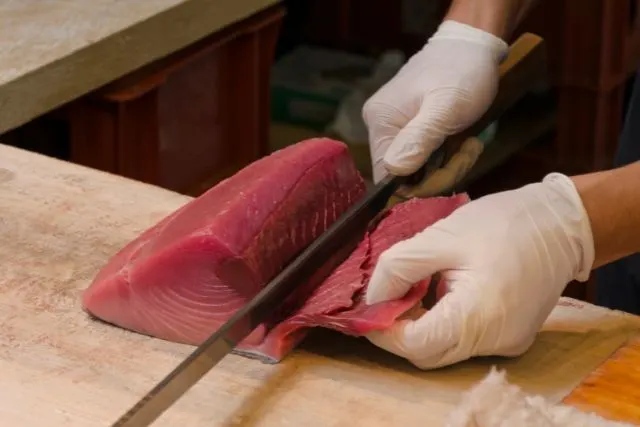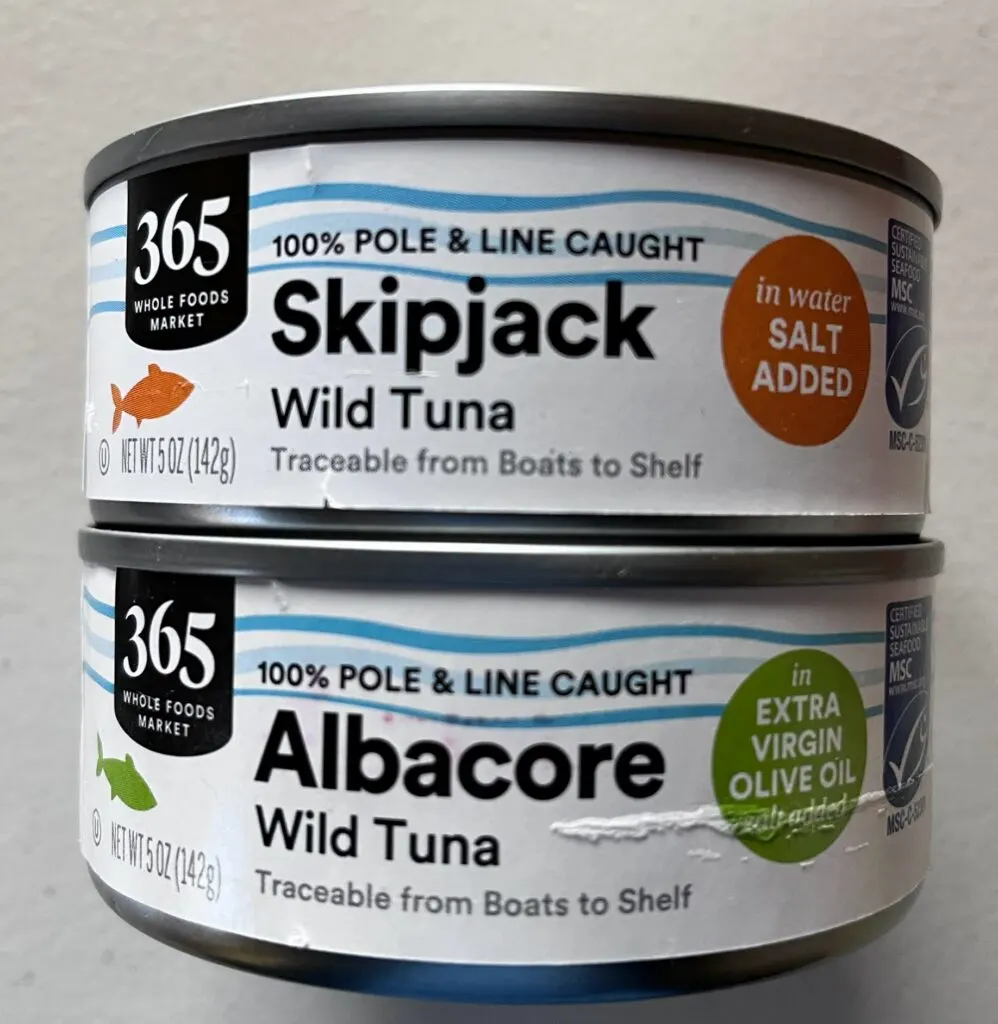When we’re busy and want to eat something healthy, we often reach for a can of tuna. But is a can of tuna really healthy? Is fresh tuna a healthier option?
If you have wondered about these questions, then you have come to the right spot. In this article, I will be doing a comparison of both fresh and canned tuna.

I will be comparing the nutritional value, mercury content, how to use each one, and their storage and availability. We will even dive into the flavor and texture of both fresh and canned tuna.
Nutritional Comparison
Tuna is an excellent way to get lean protein in your diet. But how do fresh and canned tuna compare nutritionally to each other?
To find out the answer to that question, I will be comparing fresh tuna and canned tuna. There is quite a variety of tuna that is canned. One common tuna is albacore but when comparing canned tuna with fresh tuna, I wanted the comparison to be fair. So I will be comparing two types of fresh tuna that are also canned: Skipjack and Yellowfin.
The serving size of a can of tuna will vary from the serving size of fresh tuna. With that in mind, my comparisons will be based on a true weight-for-weight comparison of 100 grams per serving.
The nutritional information for canned tuna is based on tuna that has been canned in water.
Nutrition Type |
Canned Tuna (100g) |
Fresh Yellowfin Tuna (100g) |
Fresh Skipjack Tuna (100g) |
|
Calories |
86 kcal |
109 kcal |
103 kcal |
|
Protein |
19.4g |
24.4g |
22g |
|
Fat |
0.96g |
0.49g |
1.01g |
|
Carbohydrates |
0g |
0g |
0g |
|
Fiber |
0g |
0g |
0g |
|
Sodium |
247 mg |
45 mg |
37 mg |
Examining our contestants’ side-by-side shows how comparable they are to each when it comes to calories, fat, and protein content. Canned tuna is lower in calories but it is exceedingly high in sodium. Fresh yellowfin is higher in protein and lower in fat while Skipjack is lower in sodium.
Next, we will compare the vitamins and minerals in each type of tuna. 10.1 mgYou can visit the USDA website for a more comprehensive list of the vitamins and minerals in each type of tuna.
When it comes to nutritional comparison, you can see from the comparison chart below that fresh yellowfin is much higher in vitamins and minerals than both canned tuna and fresh Skipjack.
Nutrition Type |
Canned Tuna (100g) |
Fresh Yellowfin Tuna (100g) |
Fresh Skipjack Tuna (100g) |
|
Calcium |
17 mg |
4 mg |
29 mg |
|
Iron |
1.63 mg |
0.77 mg |
1.25 mg |
|
Magnesium |
23 mg |
35 mg |
34 mg |
|
Phosphorous |
139 mg |
278 mg |
222 mg |
|
Potassium |
179 mg |
407 mg |
407 mg |
|
Selenium |
70.6 mcg |
90.6 mcg |
36.5 mcg |
|
Fluoride |
18.6 mcg |
– |
– |
|
Niacin |
10.1 mg |
18.5 mg |
15.4 mg |
|
Vitamin B12 |
2.55 mcg |
2.08 mcg |
1.9 mcg |
|
Vitamin A |
57 IU |
60 IU |
52 IU |
|
Vitamin D |
47 IU |
69 IU |
– |
|
Cholesterol |
36 mg |
39 mg |
47 mg |

Mercury Content
For many people, when they are trying to decide if tuna, whether canned or fresh, is a healthy food, it all comes down to the amount of mercury in the fish. Mercury is found in all wild fish, thanks to water pollution.
As the fish swim and eat, the amount of mercury in their system naturally increases. The amount of mercury in fish can pose serious health risks for us humans if we consume too much fish.
Some of the dangers associated with high mercury consumption are increased depression and anxiety, increased cholesterol, and high blood pressure. Women who are pregnant, breastfeeding, and young children need to be especially careful when consuming any fish.
On the positive side, eating tuna is still considered healthy and does not pose a threat if you consume tuna in moderation. The comparison chart below shows the level of mercury found in each type of tuna.
The amount of mercury in each type of tuna is low, however, canned tuna contains lower levels of mercury per 100g than fresh Yellowfin or Skipjack.
Canned Tuna (100g) |
Fresh Yellowfin Tuna (100g) |
Fresh Skipjack Tuna (100g) |
|
0.95 g |
1.64 g |
1.3 g |
Uses Comparison
Tuna is a very versatile fish that is easy to cook with but which is better, cooking with canned or fresh tuna?
You can use canned tuna for the same recipes that call for fresh tuna. Canned tuna has added sodium that needs to be taken into account when cooking with salt or oil.
Canned tuna is “cooked” in the sense that it was either heated before or after going into the can. Tuna that is heated inside the can will have much more flavor and many of its original nutrients that can be lost when heated before going into the can.

Here are some suggestions when eating canned tuna:
- Mediterranean Pasta – Mix tuna with cooked noodles, kalamata olives, and capers. Top with grated mozzarella cheese.
- Tuna Patties – Mix tuna with crushed crackers and one beaten egg. Mix everything together. Form the tuna into patties and saute in a lightly oiled skillet until browned, about 3 minutes on each side.
- Stuffed jalapeno poppers – Slice raw jalapeno peppers in half. Mix tuna, cream cheese, and cheddar cheese. Stuff the jalapeno with the tuna and cheese mixture. Bake until golden and bubbly.
- Use canned tuna to add protein to any salad or sandwich.
Fresh tuna is also very versatile and only takes a few minutes to cook. You can make it into tacos, have it on top of your favorite salad, it is even good just on its own. When fresh tuna is grilled just right, you will think you are eating a meaty steak.
Both fresh and canned tuna are easy to cook with. It all boils down to the amount of time you have.
Storage and Availability
Canned tuna is “cooked”, giving it an extended shelf life of at least a year. This makes it great to have in your pantry and with your emergency supplies. You never have to worry about heating, cooling, or cooking tuna. Just keep an eye on that expiration date.
Canned tuna is also readily available at just about every market where food is sold. You can find canned tuna in a wide variety of flavors now, too.
One convenience with tuna is that you can now find it in bags. This makes it so much easier to eat tuna when you are on the run.
Fresh tuna is more expensive and maybe a little more difficult to find, depending on where you live. Fresh tuna also has a very short shelf life, especially if it is not frozen.
When it comes down to storage and availability, canned tuna is much more accessible and easier to store than fresh tuna.
Flavor/Texture Comparison
The flavor and texture of canned tuna will vary depending on which type of tuna was canned. Tuna that is still raw when canned will retain more flavor than tuna that is heated before being canned.
Different tuna companies use different methods so go online and check out the brand you like to see how they pack their tuna.
Canned tuna and fresh tuna are very similar when it comes to flavor and texture. There is not much flavor in either one, which makes it great to cook with. And the texture of fresh tuna that has been cooked is flaky like canned tuna.
We need your help to find out which the public favorite is when it comes to taste between Canned and Fresh Tuna. Please tell us which you like best between the two, and once you vote, the winner so far will be revealed (no personal information is required to vote).
Related Articles
Rice Krispies Vs. Corn Flakes (Which is Best?)
What’s the Difference Between Creamed Corn and Sweet Corn?
Canned White Corn Vs. Canned Yellow Corn
